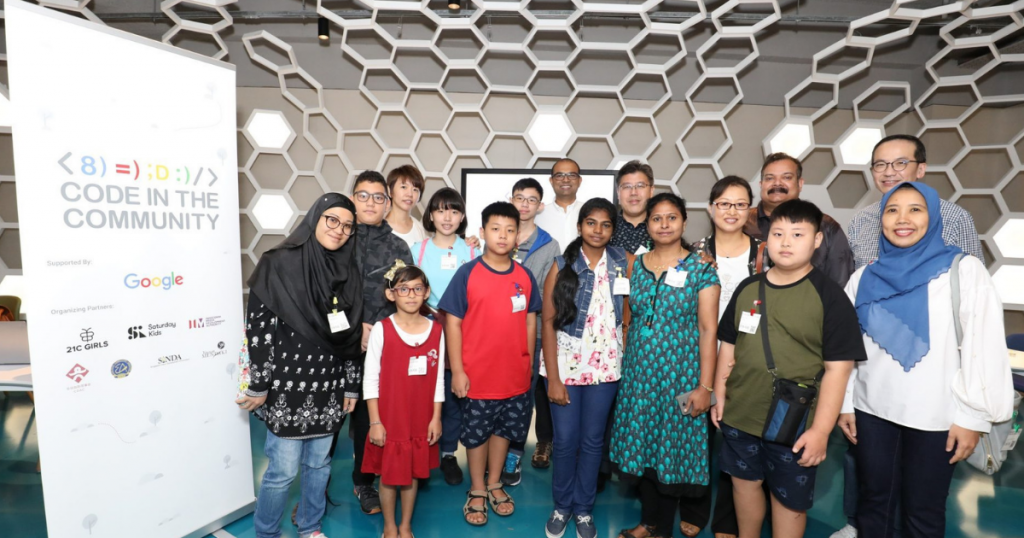I used to be an avid reader when I was young and would visit the library often to borrow books to read.
Back then, storytelling sessions were held at the children’s corner and computers had dial-up internet.
These days when I do visit the library, there are now storytelling sessions of different genres, arts and crafts workshops, IT classes for seniors, seasonal events, and even movie screenings.
Now, children and young teens can even attend free coding classes at libraries and community centres in the heartlands, thanks to Google.
Code in the Community is the Google-sponsored initiative rolled out in 2017 in partnership with coding schools SaturdayKids, who is the main organiser coordinating the lessons and volunteers and creator of the curriculum, and 21C Girls.
It has received support from the Infocomm Media Development Authority (IMDA), and the four self-help organisations for the different racial groups in Singapore which are SINDA, CDAC, Mendaki, and EA.
I had the opportunity to sit in on one of the coding classes teaching Python that’s held at Yishun Public Libary.
Kids Can Code

The Python class I attended was quite full when I arrived, students were already seated with the laptops issued by the programme ready in front of them.
Jet New, a volunteer, is the teacher and he’s assisted by a few other volunteers.
This year is the second run of Code in the Community and there are usually about 100 volunteers each run.
The lesson that day was on coding a Hangman game, a word game where the player has to guess the word correctly as every incorrect guess will result in a ‘life’ lost.
The game is over when the player loses all of their ‘lives’.

I was paired with 13-year-old Lee Hong Wei who seemed eager to get started on the coding part.
After going through the lecture part of the segment, Jet instructed the students to attempt the exercise themselves, and Hong Wei quickly started coding.
Whenever he faced a problem that he couldn’t solve, he’d raise his hand to get help and was curious as to how the volunteers or Jet managed to fix it for him.

After about 20 minutes or so of tutorial time, Jet resumes his lecture, moving on to another aspect of the lesson.
Coding might seem like a profound and technical subject that can take years to learn or master – but that’s not what I thought during this class.
Students didn’t seem to be unsettled by the technical terms, in fact, Hong Wei was already trying the next exercise as Jet went on.
Jet’s explanations were easy to understand and he would further supplement the notes on the screen by drawing out and breaking down what seemed, to me, like complicated Python functions on the whiteboard.
When Jet posed a question to the class, Hong Wei would answer, and if students were still unclear, they were not shy to ask Jet to repeat.

The two-hour class passed by in a flash, with Jet wrapping up the class with a quick demonstration on how he created a Sharingan using the Turtle graphics, a red eye with black dots surrounding the pupil seen in the anime Naruto.
Programming Hones Problem-Solving Skills
Hong Wei shared with me that he knew about Code in the Community from CDAC and that he used to take the class at the centre before transferring to Yishun Public Library.
Some of the things he’s coded since he enrolled in the programme are spirals, stackable blocks, and another game.

When I asked him if coding is easy, he scrunched up his face and said, “Okay ah,” and chuckled.
Even though I didn’t try coding during the lesson, I learnt that the process is logical – and I also realised it’s not as difficult as I thought it was.

At one point in class, Jet had met with a problem as the program wasn’t showing the right result and it took him and the volunteers a while to pinpoint the problem and solve it.
When they did manage to correct the issue, it felt like a great relief, even to me as a passerby sitting in on a class.
I left the class understanding that programming is like a script of causes and effects, and if there was an error it’s probably because somewhere in a line of code, there was a wrong input.
One of the challenges Jet and the volunteers face when teaching coding and imparting programming knowledge to children is that it’s an individual activity because everyone goes at their own pace.

Some of these students are as young as Primary 6 (12 years old) so they haven’t learnt things like prime numbers or coordinates, and Jet and the volunteers have to teach them during the class, Jet told me.
Perhaps in the future, maths lessons in schools can incorporate learning how to code so curious students like Hong Wei can practise what they learnt if they don’t have resources to do so at home.
Programming Future Coders

Early last month, 550 students from the first two batches of Code in the Community 2018 had a graduation ceremony at Google Singapore’s office.
These students, who are from less-privileged backgrounds, are now equipped with basic coding skills that enable them to imagine, invent, and tinker with technology.

In 10 weeks, students can design and create an artwork, a quiz, and even a video game using the different programming languages and concepts taught.
Code in the Community aims to prepare 3,000 young Singaporeans from less well-to-do backgrounds to develop computational thinking and skills, and to get them excited about a future career in tech.
There are now seven locations islandwide where a young and aspiring programmer can go to get a headstart.

For children aged between 8 to 11, they can enrol in the Junior class where they’ll learn the basics of computational thinking with the Scratch software.
For children aged between 12 to 15, they can sign up for the Senior class where they’ll learn basic computer science concepts with Python, a text-based programming language.
The third edition of Code in the Community will commence on 26 January 2019.
To register and to find out more about eligibility requirements, visit the Code in the Community website here!
Featured Image Credit: Google
Also Read: No Queues, No Cash: How I Enjoyed A 3-Day Holiday In Hong Kong Using Just An App










